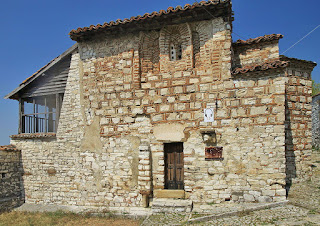OUR LADY'S SHROUD AND WINDING SHEET
Feast Day - January 25
The translation of the shroud or winding sheet of Our Lady from her Tomb in Palestine to Constantinople occurred in the fifth century, and it's feast day is January 25.
 |
| Church of Saint Mary, Blachernae |
Around the year 450, Marcion, the Eastern Roman Emperor, and the Empress Pulcheria, paid for the construction of a church that was located near a fountain of water that was believed to have healing powers. The church was at a place called Blachernae, which was a suburb in the northwestern section of Constantinople. Besides the spring already mentioned, there were a number of churches already built in the area, but the greatest of them would be the Church of St. Mary of Blachernae.
When all was ready, the Emperor sent a message to Juvenal, the first Orthodox Patriarch of Jerusalem, requesting he sends the sacred remains of the Blessed Virgin Mary to them to be honoured in the new church dedicated to Our Lady.
It is the tradition of the Church that Our Lady passed the remaining days of her life at Jerusalem, and it was commonly known that the tomb of the Blessed Virgin was located in Gethsemane. Juvenal calmly explained to the Emperor that the sacred body of the Blessed Virgin Mary had been assumed into Heaven body and soul, so there were no bodily relics for him to send. He did, however, send a Casket and the winding sheet, or shroud of Our Lady.
The emperor Leo I constructed a separate building near the church to house the holy reliquary which contained the Mantle and Robe of Our Lady. This super relic made the church a super Sanctuary, and the Emperors enclosed the church behind a protective wall and began to build what became known as the imperial palace of Blachernae.
There was also a famous icon of Our Lady kept in the church. Painted on wood, it is now known as the “Blachemitissa.” In 626 Constantinople was attacked by a combined Army of Persians and Avars while the Emperor Heraclius was fighting the Persians in Mesopotamia. The Patriarch Sergius led a procession along the ramparts carrying the icon just mentioned. It was later learned that the fleet of the Avars was destroyed at sea, and that the Khan of the Avars had not attacked the city because he had been terrified at the sight of a young woman in armour adorned with jewels guarding the walls.
There were other occasions in which the Blessed Virgin was known to have given her protection to the Byzantines, such as the time when a Russian fleet was threatening to invade. The mantle of the Blessed Virgin, which was also being housed with the other relics, was dipped in the ocean while the people prayed for divine protection. A few days later the Russian fleet was destroyed.
The church of St Mary was destroyed by fire in 1070, but was later rebuilt. Eye-witnesses said the supporting columns were made of green Jasper, and that the capitals and bases were of gilded white marble. The church was destroyed by fire once again in 1434.




Post a Comment